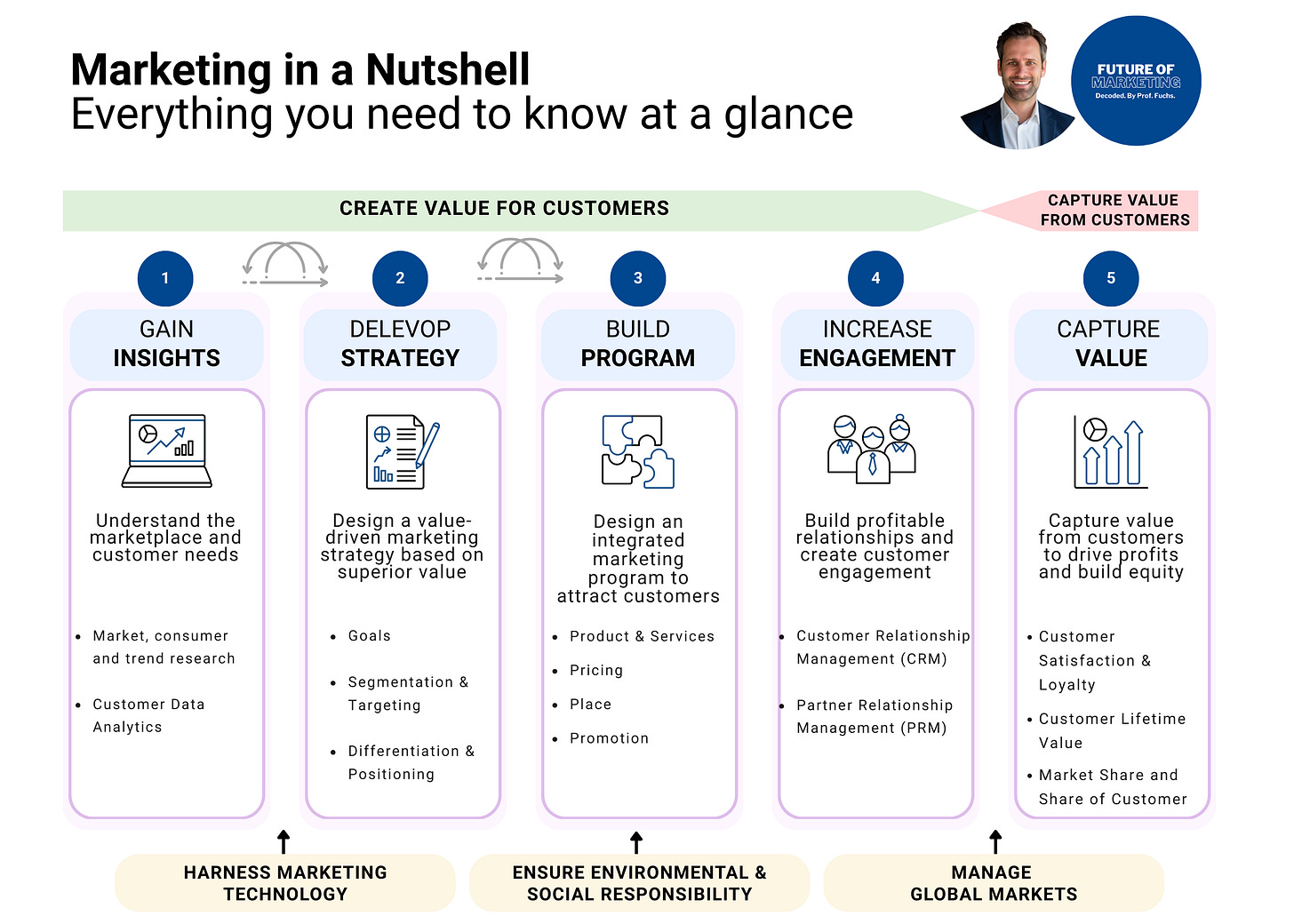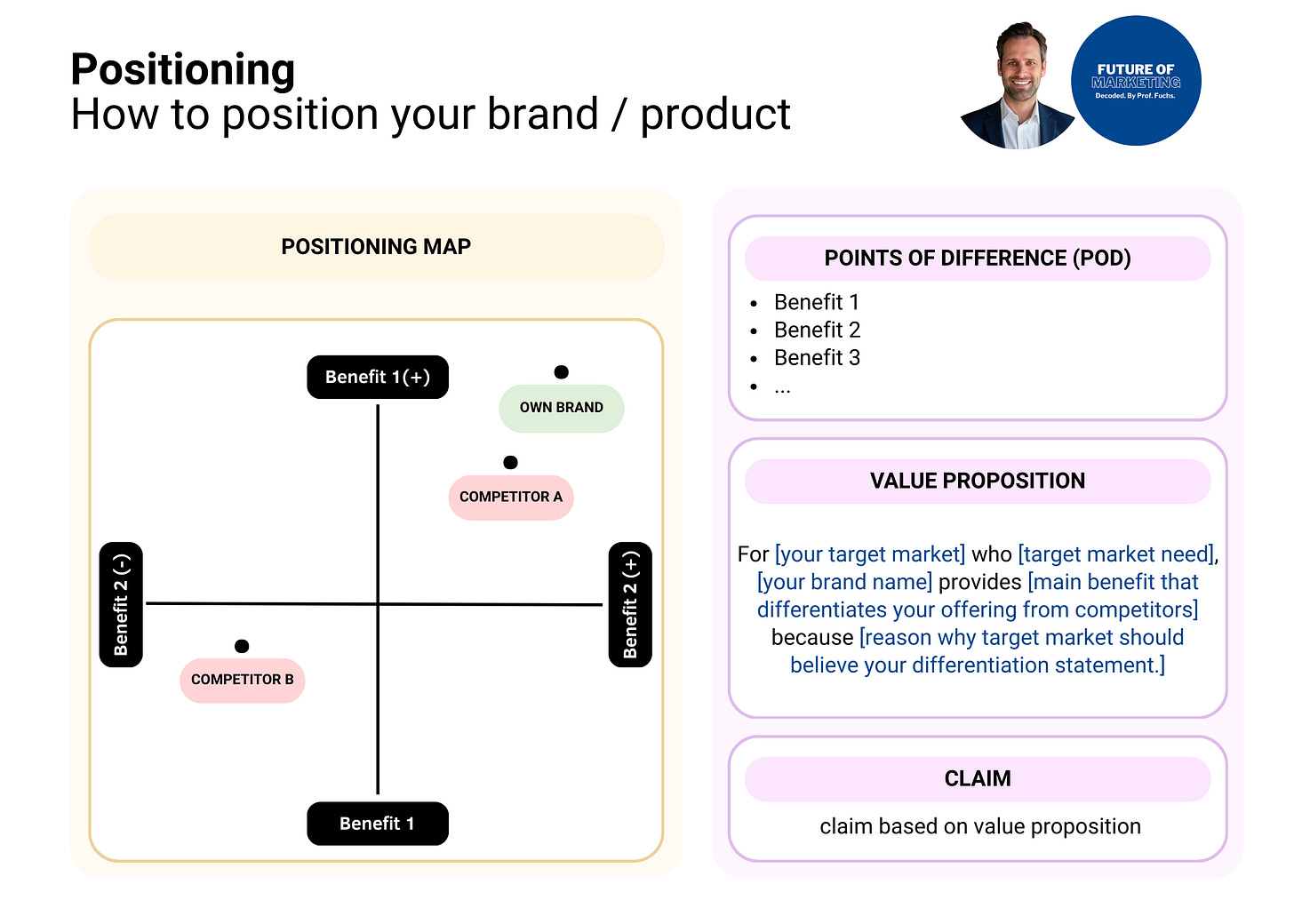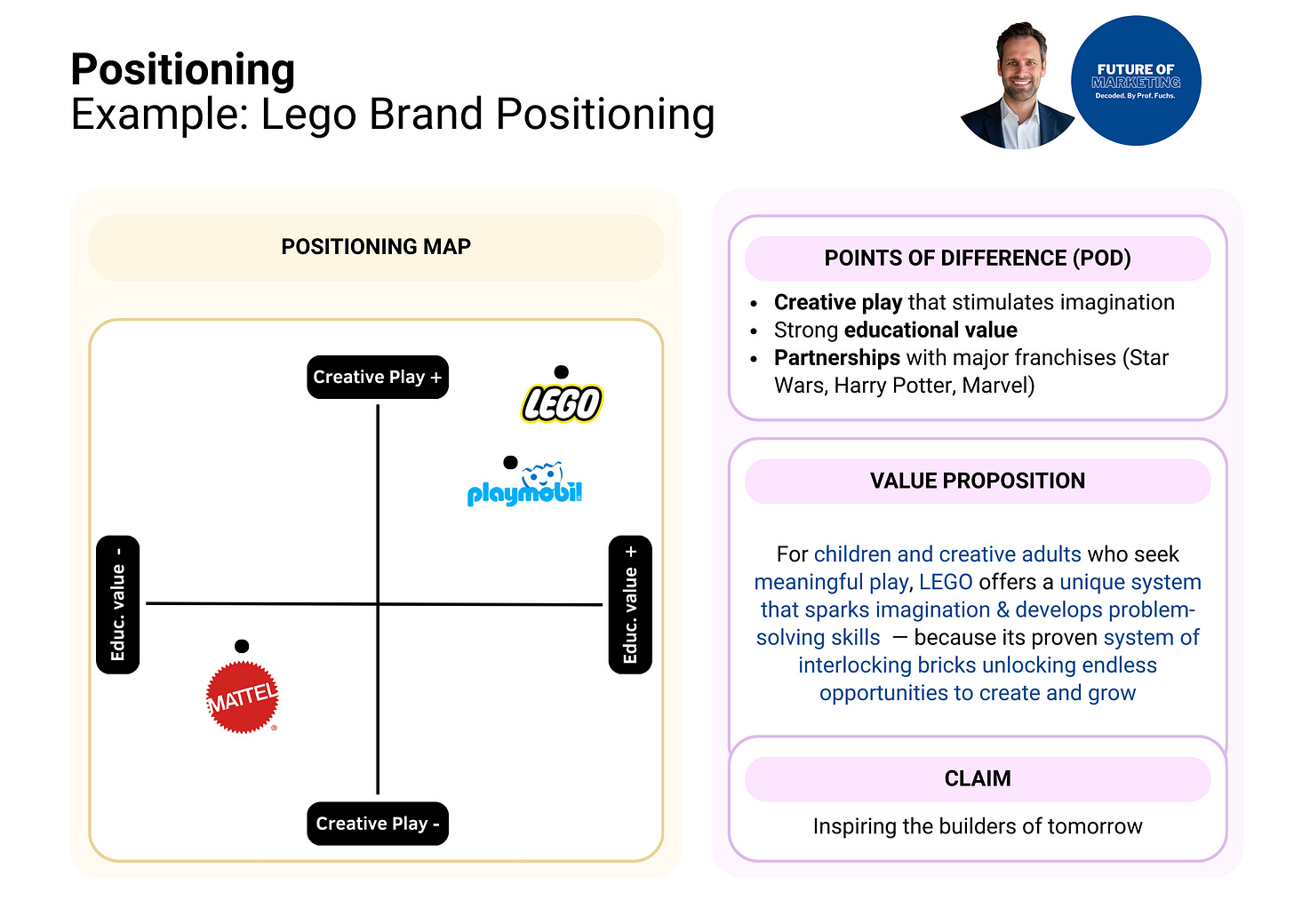Marketing in a Nutshell
Everything you need to know about Marketing at a Glance
For decades, marketing has been described as both art and science. But when you step into most organizations, it often feels fragmented. Endless tools, endless frameworks, endless buzzwords. Professionals and students alike ask a simple question: Can you give me the big picture?
That is exactly what this model tries to deliver: Marketing in a Nutshell. One simple overview, five core steps, three cross-cutting principles. It is not a new invention but a synthesis — bringing together the ideas of Kotler, Drucker, and others into one coherent map. A reminder that, despite new technologies, the essence of marketing has not changed.
Source: Prof. Dr. Andreas Fuchs
The Heart of Marketing
The famous Marketing Professor Philip Kotler defines marketing as “the science and art of exploring, creating and delivering value to satisfy the needs of a target market at a profit.”
That definition captures a simple but profound truth: marketing is about creating consumers. Not just moving products, but identifying unmet needs, quantifying markets, and designing offerings that bring real value.
Peter Drucker (Management Goat) went further. For him, marketing was not a separate function but the whole business seen from the customer’s point of view. Success, he argued, is not determined by the producer but by the customer. The modern concept of marketing, therefore, puts the customer at the center — not as a slogan, but as the ultimate arbiter of business survival.
The Five Steps of Marketing in a Nutshell
So how do we put this philosophy into practice? The five steps of the Marketing in a Nutshell model are one way to capture the essence.
Step 1: Gain Insights
It all begins with understanding. Who are your customers? What are their needs, wants, and frustrations? What forces shape your market?
This requires market research, consumer analysis, and trend scanning. But more than that, it requires empathy: the ability to see the world through the customer’s eyes. Kotler and Armstrong highlight five key concepts to grasp here:
Customer needs, wants, and demand.
Market offerings (products, services, experiences).
Customer value and satisfaction.
Exchange and relationships.
Markets themselves.
In today’s data-driven age, this stage is powered by customer analytics, surveys, ethnographic research, and AI-driven insights. But the principle remains timeless: before you can create value, you must first listen.
Step 2: Develop Strategy
Once insights are gathered, the next step is to design a marketing strategy based on superior value. At its core, strategy is about choice: Which customers will we serve? and How will we serve them better than anyone else?
This involves two key elements:
Segmentation and Targeting: Dividing the market into distinct groups and deciding which ones to prioritize. 👉 Which customers will we serve?
Differentiation and Positioning: Identifying what makes your brand stand out and anchoring this differentiation in the minds of your target customers. 👉 How will we serve them better than anyone else?
Source: Prof. Dr. Andreas Fuchs
How to Position Your Brand:
To make positioning tangible, use the template:
Points of Difference (POD): Define 2–3 benefits that make your brand distinct and more valuable.
Positioning Map: Place your brand and competitors on the map (e.g. Benefit 1 vs. Benefit 2) to visualize where you stand.
Value Proposition: Use the formula:
For [target market] who need [target need], [brand name] provides [main benefit] because [reason to believe].
Claim: Condense the value proposition into a simple, memorable message.
👉 The outcome is a clear, credible, and defensible position that guides all further marketing actions.
Theory becomes vivid with practice. Let’s take LEGO as an example:
Points of Difference (POD):
• Creative play that stimulates imagination
• Strong educational value
• Partnerships with major franchises (Star Wars, Harry Potter, Marvel, …)
Positioning Map: LEGO clearly differentiates itself from Playmobil and Mattel by being high on both creative play and educational value.
Value Proposition:
For children and creative adults who seek meaningful play, LEGO offers a unique system that sparks imagination and develops problem-solving skills — because its proven system of interlocking bricks unlocks endless opportunities to create and grow.
Claim: Inspiring the builders of tomorrow
This shows how the abstract idea of “strategy” becomes concrete: with the right positioning, LEGO not only builds toys — it builds a brand philosophy rooted in creativity, learning, and trust.
Step 3: Build Program
A strategy without execution is nothing. That is why the third step is to build a concrete marketing program, derived from your valued-based marketing strategy (step 2).
This means designing the marketing mix, often summarized as the 4Ps:
Product (or service): the offering itself, including design, features, and quality.
Price: not just a number, but a positioning signal.
Place: how you deliver and distribute.
Promotion: the communication that informs and persuades.
The task here is integration. Every element must fit together into a coherent program that brings the strategy to life.
Step 4: Increase Engagement
In the old days, this step was called “customer relationship management.” Today, it is broader: it is about engagement. Building profitable relationships, creating loyalty, and fostering genuine dialogue.
Technology makes this both easier and harder. Easier because CRM systems, marketing automation, and AI personalization can maintain constant touchpoints. Harder because customers demand authenticity. They see through manipulation.
Engagement means more than retention. It means creating communities, building trust, and sometimes even inviting customers into the innovation process.
Step 5: Capture Value
Finally, marketing must also work for the company. Value created for customers must translate into value captured by the firm.
This happens through customer satisfaction, loyalty, lifetime value, and market share. When customers are happy, they buy again, they buy more, and they tell others. The financial results — profit, growth, equity — flow from this foundation.
As Drucker said: the purpose of a business is to create a customer. But the purpose of marketing is to sustain that creation in a way that also sustains the firm.
Three Cross-Cutting Principles
Across all five steps, three principles shape success:
Harness marketing technology: from CRM systems to AI, tools must serve strategy, not replace it.
Ensure environmental and social responsibility: modern marketing cannot ignore sustainability and ethics.
Manage global markets: in a connected world, thinking globally while acting locally is no longer optional.
Marketing ≠ Selling
One of the most common confusions is to equate marketing with selling. People often say they “go for marketing” when they mean buying or selling goods. But marketing is something deeper and wider.
Selling begins after production and ends with the sale. It focuses on the seller’s needs, on short-term goals, on moving products out of the warehouse. Marketing begins much earlier and continues long after the sale. It focuses on the customer’s needs, on long-term relationships, and on building value that creates stability and growth.
Peter Drucker once put it sharply: “The aim of marketing is to make selling superfluous.” In other words: if you understand your customers deeply enough and design products and services around their needs, you do not have to “push” them. They will buy because it makes sense.
Marketing as Philosophy
The danger is to see this model as just another checklist. In reality, it is a reminder of something deeper. Marketing is not a department or a set of campaigns. It is a philosophy of business.
Selling may move goods. Marketing creates customers. Selling ends with the transaction. Marketing continues with the relationship. Selling focuses on the product. Marketing focuses on the human being who uses it.
And that makes marketing not just a business function but a lens through which to see the world: to understand needs, to imagine solutions, to create value that lasts.
👉 That is Marketing in a Nutshell. A map for professionals, students, and leaders who want to cut through the noise and return to the essence.





Thank you very much for your thoughtful feedback, Wolfgang! 🙏
It’s particularly valuable to hear this from such an experienced manager and marketing enthusiast like you are. That’s exactly the aim: to provide a clear process for winning customers and building loyalty, while ensuring all areas of the company are aligned behind a coherent customer strategy. More to come soon 🦊🎓
Thanks for the roundup. Love it.